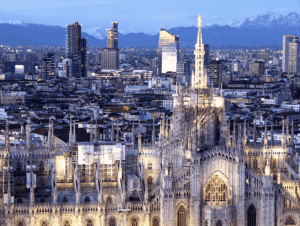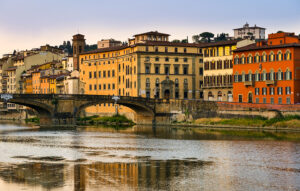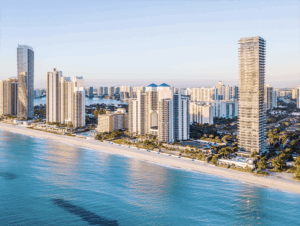Milan is experiencing a transformation that astute real estate investors recognize as a generational opportunity. The city has become Europe’s most compelling wealth destination, attracting thousands of ultra-high-net-worth individuals and reshaping its property market in ways that create multiple entry points for sophisticated international capital.
The numbers reveal a market in rapid ascension. Property prices have surged nearly 60 percent over the past decade to €5,540 per square meter, while Rome has remained essentially flat at €3,600. Rental rates have increased 50 percent over the same period, from €15 to €22.50 per square meter. Yet these figures, impressive as they are, understate the opportunity for investors who understand that Milan is still in the early stages of its evolution into a truly global city.
What distinguishes Milan’s growth from typical urban appreciation is the caliber of new residents driving demand. Goldman Sachs vice-chair Richard Gnodde, Egypt’s richest billionaire Nassef Sawiris, and advisory boutique co-founder Yoël Zaoui represent merely the visible tip of a much larger migration. The city has attracted several thousand individuals through its flat tax regime—€200,000 annually on foreign income and assets—while over 100,000 have benefited from a separate scheme offering 50 percent reductions on Italian taxable income.
This influx isn’t speculative or temporary. These are established wealth holders making deliberate, long-term positioning decisions. When surveyed, 45 percent of new enrollments at international schools in Milan are foreign nationals, primarily from the UK, US, and France—families putting down roots, not transient expatriates. This demographic shift creates sustained, multi-generational demand for premium properties that investors can confidently underwrite.
The institutional validation of Milan’s trajectory is equally compelling. Alternative investment firms including CVC, Preservation Capital, and Ares have established or expanded Milan offices, joined by hedge funds like Steve Cohen’s Point72 and Capstone Investment Advisors. These aren’t symbolic presences but substantial operations targeting Italy’s abundant family-owned businesses. Where sophisticated capital aggregates, property values inevitably follow.
For Columbus International‘s clients, the comparison with established markets reveals Milan’s relative value proposition. At €1,520 per square foot, Milan’s prime residential sector trades at a 20 percent discount to London’s €1,920, despite offering comparable lifestyle amenities and superior weather. Trophy assets—600-square-meter penthouses with full amenities—start at $8-10 million, a fraction of equivalent properties in Mayfair or Manhattan’s Upper East Side.
The city’s infrastructure development amplifies the investment thesis. The 2026 Winter Olympics, shared with Cortina d’Ampezzo, is catalyzing transportation upgrades, district renovations, and hospitality expansions reminiscent of Barcelona’s pre-1992 transformation. Smart investors recognize that Olympic-driven development creates lasting value appreciation well beyond the games themselves.
Milan’s cultural evolution provides another dimension of value creation. Thaddaeus Ropac’s new gallery in Palazzo Belgioioso, the opening of Palazzo Citterio as part of the Grande Brera complex, and Casa Cipriani’s successful launch signal the city’s emergence as a serious art market. Where galleries cluster, wealth concentrates, and property values appreciate—a pattern we’ve observed from Chelsea to Shoreditch to Miami’s Design District.
The regulatory environment offers particular advantages for international investors. Italy’s 26 percent flat rate on capital gains compares favorably to the UK’s recent increase to 34 percent on carried interest. The inheritance tax exemption on foreign assets for flat-tax residents removes a major wealth transfer concern. These aren’t temporary incentives but structural advantages that position Milan as a permanent wealth management hub.
Current market dynamics create exceptional entry opportunities. Demand substantially exceeds supply, particularly for trophy properties and large family residences. One legal partner reported a client unable to find suitable housing in Milan proper, ultimately purchasing in Lugano—illustrating the acute shortage of premium inventory. This supply-demand imbalance, combined with continued wealth migration, suggests sustained appreciation potential.
The development pipeline offers multiple investment strategies. Direct acquisition of existing properties captures immediate scarcity premiums. Pre-construction positions in luxury developments—several major projects are underway in the Porta Nuova district and historic center—offer enhanced returns through early-stage pricing. Even commercial properties benefit as international firms expand their Milan presence, driving office rents and valuations upward.
What makes Milan particularly compelling for cross-border investors is its position within broader portfolio strategies. The city offers eurozone exposure without France’s wealth taxes or Germany’s regulatory complexity. It provides cultural richness without London’s political uncertainties. For American investors, it represents European diversification with familiar luxury brands and English-speaking professional services.
The lifestyle component cannot be overlooked as a value driver. Milan’s proximity to Lake Como (45 minutes), Portofino (two hours), and premier Alpine resorts (three hours) creates a unique combination of urban sophistication and recreational access. This geographical advantage attracts not just residents but also secondary home buyers who maintain Milan bases while enjoying Italy’s diverse attractions.
The acceleration of wealth migration following the UK’s non-dom abolition suggests we’re witnessing the early stages of a multi-year reallocation of European wealth. Milan, rather than merely benefiting from London’s policy changes, is establishing itself as a permanent fixture in the global wealth management ecosystem alongside Geneva, Monaco, and Singapore.
For developers and investors partnering with local operators, opportunities abound. The shortage of large luxury residences, international-standard office spaces, and branded hospitality properties creates clear development paths. The city’s historic architecture offers conversion opportunities that combine heritage appeal with modern amenities—projects that command premium valuations from culturally sophisticated buyers.
Risk factors exist but appear manageable. The corruption investigation into certain developments, while concerning, involves specific projects rather than systemic issues. Italy’s bureaucracy remains challenging, but experienced operators navigate it successfully. The key is partnering with established local expertise while bringing international capital and standards.
Looking forward, Milan’s trajectory appears remarkably clear. The combination of sustained wealth in-migration, limited premium supply, infrastructure investment, and cultural development creates multiple value drivers operating simultaneously. Unlike speculative booms driven by single factors, Milan’s appreciation reflects fundamental demographic and economic shifts.
The opportunity window remains open but won’t persist indefinitely. As more international investors recognize Milan’s transformation, competition for prime assets will intensify. Early movers who act while the market still offers relative value compared to peer cities will capture the greatest appreciation.
For Columbus International’s clients evaluating European opportunities, Milan represents that rare convergence of timing, fundamentals, and relative value. The city isn’t just attracting wealth; it’s creating the ecosystem to retain and multiply it. In this environment, strategic property investment doesn’t just preserve capital—it positions investors at the center of Europe’s most dynamic wealth migration.
Richard Tayar is the founder of Columbus International, an international real estate firm bridging markets between the United States and Italy, with focus on New York, Milan, Tuscany, and Miami.



